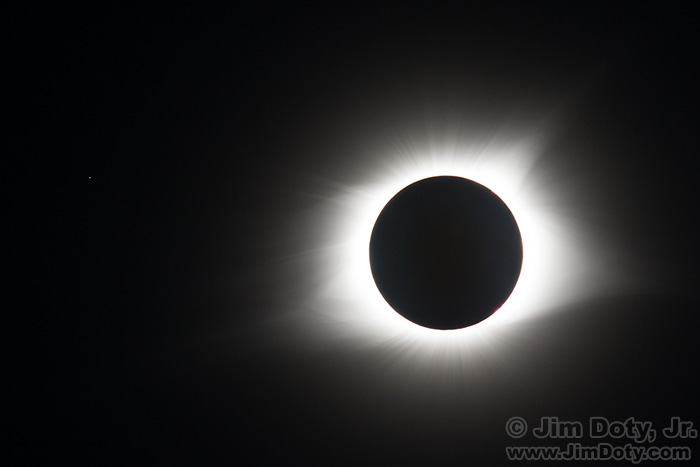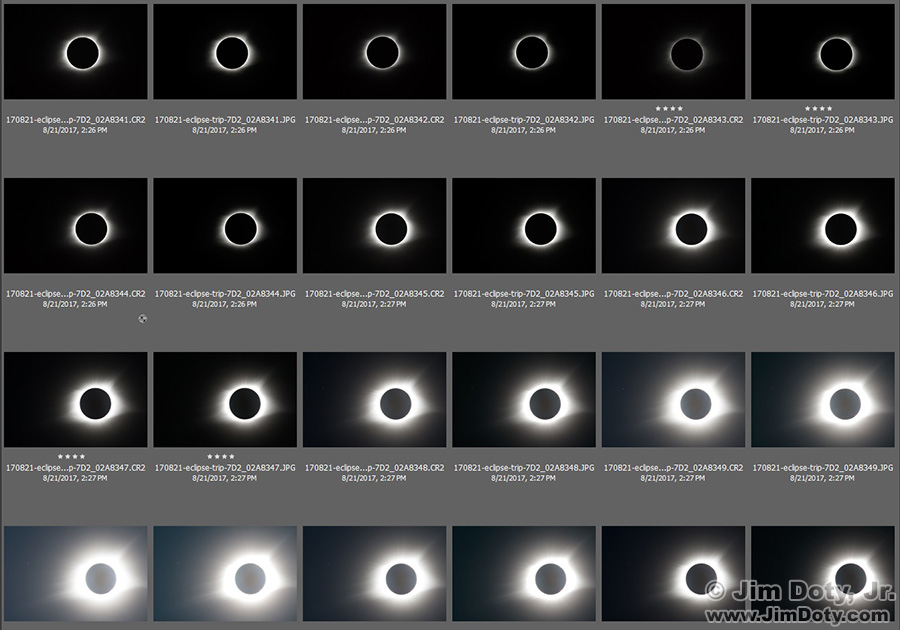
The Sun’s Corona during a total eclipse. The star Regulus is to the left. Click for a larger version.
Totality of an eclipse is an extraordinary and never to be forgotten experience. It is one of nature’s grandest spectacles. The eclipse glasses come off and people are rapt in wonder. Where I was, everyone and everything went silent. When totality ended as the sun emerged a cheer went up and there was spontaneous applause. It is no small wonder people get eclipse fever and are already planning for the next eclipse in 2024.
Unlike the stages of the eclipse before and after totality (which can all be shot with the same exposure), totality is best shot with a wide variety of exposures to capture varying degrees of the sun’s corona and any solar flares (see my next article).
When totality arrived I removed the solar filter, but left the aperture (f/11) and ISO (800) unchanged. The less I had to worry about during the 2 1/2 minutes of totality the better. As you can see from the screen capture of Adobe Bridge, the longer the shutter speed, the greater the extent of the corona that was captured. I tried shutter speeds from 1/400 second (top right) to 0.3 seconds (bottom left). For the image at the top of this article the shutter speed was 1/25 second.
At an effective focal length of 896mm, vibration can be a serious issue at any shutter speed and especially longer shutter speeds. I was in Live View Mode to take the pictures (which means the mirror was up all the time to eliminate vibration due to mirror slap), I used an electronic cable release, and I set the self timer for a two second delay for all images, even at faster shutter speeds.
You can combine several of your exposures into a high dynamic range (HDR) image, but I opted for a single exposure for the image at the top of this article. I will get around to an HDR image later on.
More information on eclipse photography and photographing the sun any time is in my series of eclipse article linked below.
The Great American Eclipse Series
The Great American Eclipse Series  – All of my eclipse articles are listed at this link. This is the 40th article in the series.
Eclipse Photography
How To Photograph the Sun (and an Eclipse) with Lee and Other High Density Solar Filters
How to Process a “Blue Sun†Photographed with a Lee Solar Filter
How to Photograph the Sun (and an Eclipse) with a “White Light†Solar Filter
Practice Your Solar Eclipse Photography Skills Now!
Photographing the Eclipse: How Big Do You Like Your Sun?
HDR Photography During Eclipse Totality
How to Choose the Right Lens for Eclipse Time Lapse Photography
How to Get Critical Focus in Live View Mode with a Magnified Image
Eclipse Imagery

